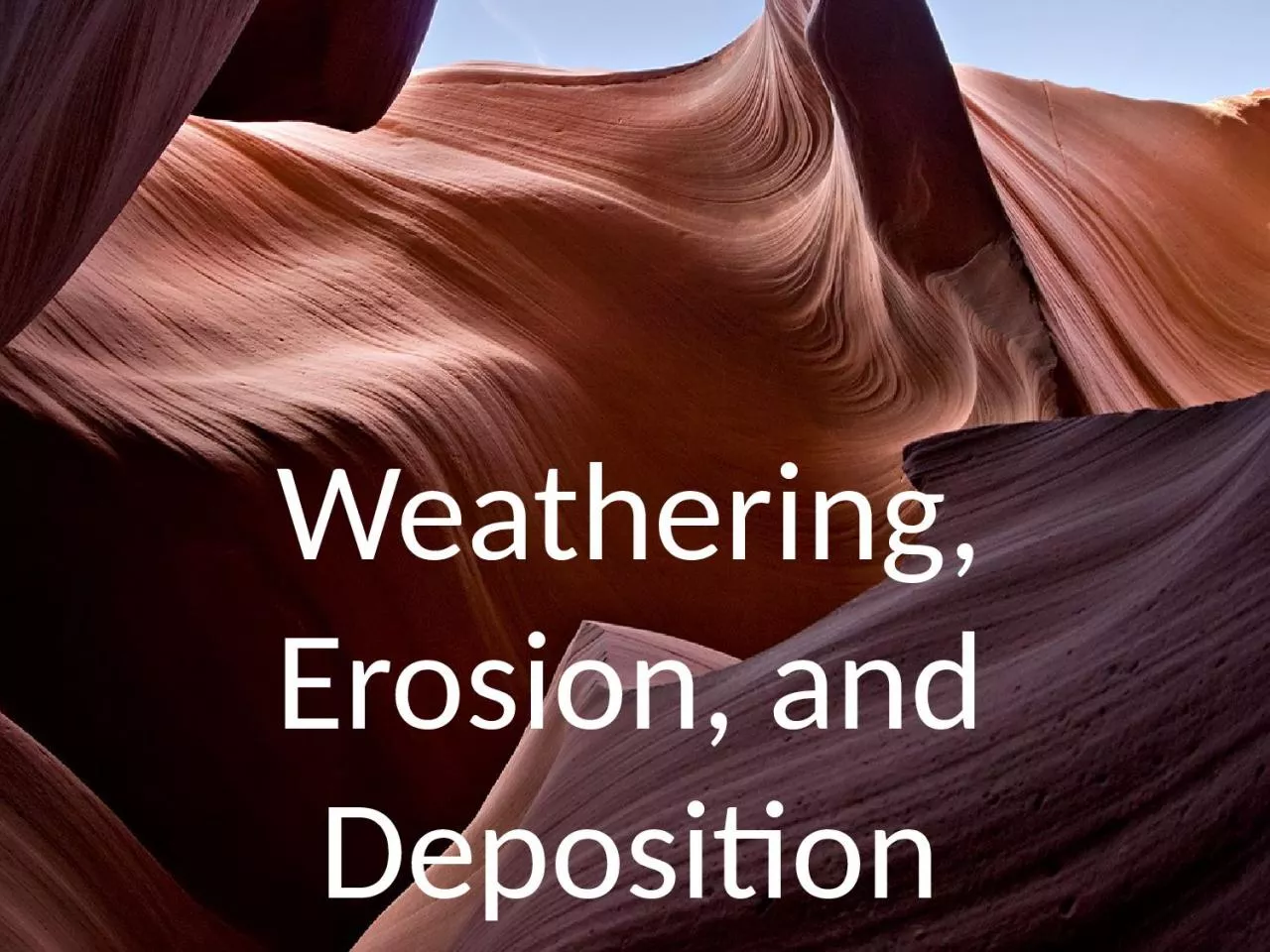

Weathering the breaking up of rock into smaller pieces Erosion the movement of sediment from place to place by wind water ice or gravity Deposition the redepositing of sediments in a new location following erosion ID: 1021768
Download Presentation The PPT/PDF document "Weathering, Erosion, and Deposition" is the property of its rightful owner. Permission is granted to download and print the materials on this web site for personal, non-commercial use only, and to display it on your personal computer provided you do not modify the materials and that you retain all copyright notices contained in the materials. By downloading content from our website, you accept the terms of this agreement.
1. Weathering, Erosion, and Deposition
2. Weathering: the breaking up of rock into smaller pieces Erosion: the movement of sediment from place to place by wind, water, ice, or gravityDeposition: the re-depositing of sediments in a new location following erosion
3. Two types of weathering:Mechanical (physical) when rocks are broken apart by a physical forceChemical weathering that changes the makeup of rocks and mineral
4. Types of Mechanical Weathering: Abrasion When moving water or wind that is carrying sand or other particles, wear away rock surfaces
5. Ice Wedging Freezing water in the cracks of rocks expands causing rock to be further fractured
6. 3. UploadingUploading is the expanding of high pressure rock when exposed to a lower pressure (normally at the surface).Intrusive igneous rocks form deep in the earth’s crust, and may have zones of weakness in them. When these rocks are exposed (through erosion of overlying rock) they expand, and the zones of weakness open up as joints.Devil’s Postpile National Park – Mammoth Lakes, California
7. Uploading (Exfoliation)
8. Organic Activity Plants , animals, or people can loosen soil and rocky material
9. Organic activity in plants is also called root wedging or root action.
10. 5. Gravitational ImpactThis form of weathering includes landslides and glaciers. CreepRock slideMudflowEarthflowLandslides occur when gravity pulls soil and rock downward, breaking it into smaller pieces. This is also erosion because sediment is moved.
11. Mass wasting: the transfer of sediments downhill due to gravity
12. Glaciers carry boulders along on their underside. These boulders grind away the earthen surface underneath.
13. Chemical Weathering:Chemical weathering breaks down the bonds holding the rocks together, causing them to fall apart, forming smaller and smaller pieces. Chemical weathering is much more common in locations where there is a lot of water. This is because water is important to many of the chemical reactions that can take place.Warmer temperatures are more favorable to chemical weathering.The most common types of chemical weathering are oxidation, hydrolysis, dissolution, plant acid and hydration.
14. 1. OxidationOxidation occurs when rocks containing metals are combined with oxygen to form “rusts”. The areas in these rocks that are oxidized are weaker and more susceptible to physical weathering.
15. 2. HydrolysisHydrolysis literally means reaction with water. It is a chemical process in which a molecule is cleaved into two parts by the addition of a molecule of water. Hydrolysis is a chemical weathering process affecting silicate and carbonate minerals. In such reactions, pure water ionizes slightly and reacts with silicate minerals. An example reaction:Mg2SiO4 + 4H+ + 4OH- ⇌ 2Mg2+ + 4OH- + H4SiO4
16. 3. DissolutionDissolution weathering occurs when slightly acidic water dissolves rock.
17. Dissolution (Carbonation)Carbonic acid is formed with carbon dioxide and water combine. This weak acid can weather away rock. H2O + CO2 H2CO3 Though weak, when carbonic acid is combined with a mineral like calcite (CaCO3) common to limestone, calcium and bicarbonate ions are released and carried off by groundwater. CaCO3 + H2CO3 Ca+2 + 2 HCO-3
18. Dissolution (Sulfuric Acid)Sulfurous gas (given off by volcanoes and factories) can dissolve in water to form sulfuric acid. This acid can fall to the earth and react with rock. SO2 + H2O H2SO4
19. 4. Plant AcidsSome mosses and lichens produce weak acids that seep into rock and dissolve the minerals that hold them together.
20. Hydration is a form of chemical weathering that involves the rigid attachment of H+ and OH- ions to the atoms and molecules of a mineral.When a rock’s minerals take up water, the increased volume creates physical stresses within the rock.5. Hydration
21. Factors influencing the rate of weathering include: Amount of surface area exposed to chemical weatheringAs the rock breaks down into smaller pieces, more surface area is exposed, and the rock weathers faster. The presence of cracks or joints in the rock can allow water to penetrate and increase the rate of weathering. Different minerals weather at different ratesMarble and limestone, which are composed of calcium carbonate, dissolve readily in weakly acidic solutions.Silicate minerals weather in the same sequence as they crystallize. (Bowen's Reaction Series). Olivine crystallizes first from magma, and so is the first to weather. Quartz crystallizes last from magma, and so it is the most resistant to weathering. Climate influences weathering rates, particularly temperature and the availability of water. Warm temperatures and abundant moisture lead to RAPID WEATHERING.Rates of Weathering
22. Climate and Weathering
23. ErosionOnce rock has been weathered (broken into smaller pieces), it can be eroded (moved to other places) and deposited (laid down in a different location).Erosion can take place by water, wind, gravity, or ice.
24. DepositionDeposition is the process by which sediments are re-deposited in new locations.
25. Visit the following web site to complete Grand Canyon assignment: http://www.kaibab.org/geology/gc_geol.htm